How to Choose a Bird Feeder
 A well-designed birdfeeder should be easy to use. This tube-style model has a clear hopper, making it easy to see when it's time to refill and accommodates any type of seed. The outer cage discourages most squirrels and larger birds.
A well-designed birdfeeder should be easy to use. This tube-style model has a clear hopper, making it easy to see when it's time to refill and accommodates any type of seed. The outer cage discourages most squirrels and larger birds.Feeding birds is a great way to bring wildlife closer to home. By putting up a variety of feeders, you'll attract many different types of birds to watch and enjoy.
We all have preferences when it comes to how, what, and where we like to eat, and birds are no exception. If you enjoy watching the beauty, grace, and acrobatics of birds, a backyard feeder is a must-have. Start with just one feeder, or place multiple feeders, filled with different types of food, at various locations around your yard to create an irresistible bird buffet that will attract the widest variety of species.
In This Article
Humans have surely observed birds since the beginning of time. And we can trace the intentional feeding of birds simply for the pleasure of watching them at least back to Henry David Thoreau, who in the mid 1800s wrote of tossing unripe corn on the ground outside his cabin at Walden Pond. The habit of setting out food to attract local songbirds grew in popularity in the late 1800s, due in part to the publication of the book Birds Through an Opera Glass, a field guide by Florence Merriam Webster that surely inspired many bird fans to begin backyard bird feeding.
Over the course of the next century, bird watching and bird feeding grew into a hugely popular pastime, and today an estimated 50 million U.S. households participate in the hobby in one form or another. Like gardening, feeding birds fosters a connection with the outdoors and with other living creatures.
Bird Feeder Basics
Although they may look very different, quality bird feeders have a few common characteristics. They should all be:
- Sturdy enough to withstand inclement weather
- Designed to keep seed dry
- Easy to refill
- Simple to clean
- Designed for the type of birdseed (or other food) you plan to use
Also, consider the volume of seed they hold, and thus how often you'll need to refill them.
Types of Bird Feeders
Each species or type of bird has a particular way of eating in its natural environment. Some birds like to cling to something, such as bark, as they feed. Others prefer to have both feet firmly planted on the ground. The most successful backyard birders have an assortment of different feeders, installed at different heights to simulate the way birds feed in the wild. For your backyard bird buffet, include a variety of feeding stations, such as the following.
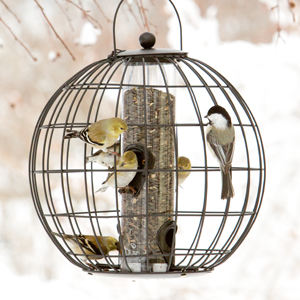
Tube feeders
These tall cylinders are usually made of clear poly or wire mesh, often with six or more feeding ports. The cylinder material influences the type of seed it can accommodate (which will also be indicated on the feeder's instructions). If the cylinder is made from a solid material or a very fine wire mesh, it will hold small thistle (nyjer) seed, which would otherwise fall out of a larger mesh. Thistle is a favorite of finches, and some tube feeders are called finch feeders. If the cylinder is made with 1/4" or larger mesh, it's ideal for larger sunflower seeds. Some tube feeders have feeding ports with perches, making them a favorite for perch-feeding birds, such as finches, bluebirds, buntings, cardinals and titmice. Others require birds to cling to the wire mesh, inviting woodpeckers, nuthatches, and chickadees.
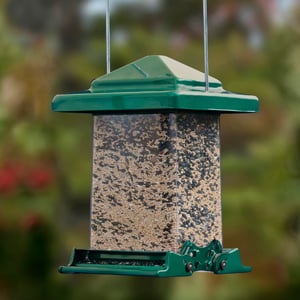
Hopper Feeders
These popular feeders contain a central reservoir that's filled with food, with holes or a slit at the bottom that allows gravity to dispense the seed onto a tray. The design of hopper feeders can be simple, or can be an elaborate replica of an ornate gazebo or cottage. As long as the functionality is sound, the birds won't care, and you can choose a feeder that complements your landscape — or simply makes you smile!
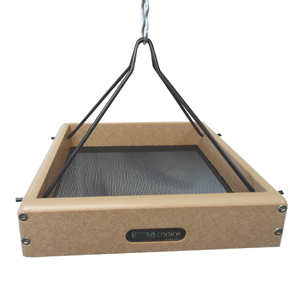
Platform Feeders.
Sometimes called tray feeders, these designs consist of an open platform, with no seed storage area. They're designed to attract ground-feeding birds, such as cardinals, juncos, grosbeaks, and mourning doves, but will attract many other birds as well. Lacking a roof, the tray must have drainage (or, ideally, be made of a fine wire mesh) to prevent seeds from sitting in water. The seed must be replenished often. Install the tray on the ground or elevated by several feet.
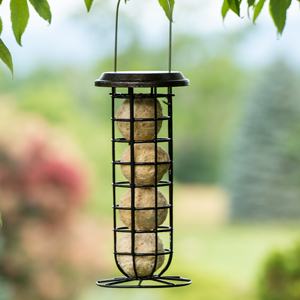
Suet feeders.
The two most common suet feeders are boxes made from metal grid for square suet cakes, and upright tubes designed for round suet cakes. Typically made from ground beef fat mixed with seeds or dried berries, suet is a high-energy, nutrient rich food that is especially attractive to woodpeckers, bluebirds, and nuthatches. Because suet tends to soften in hot weather, it used to be confined to cool-weather use; however, there are now melt-resistant suet cakes suitable for year-round use.
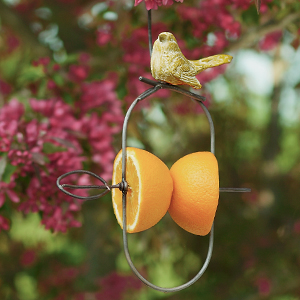
Fruit Feeders
Brilliantly colored orioles, in particular, are attracted to fresh fruit and jelly. Feeders that accommodate a half an orange, and/or have small ports for dabs of jelly, are magnets for these beauties.
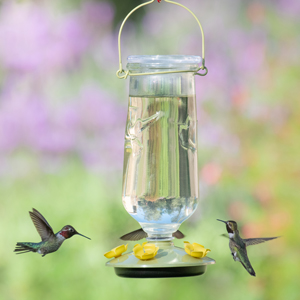
Nectar Feeders
Most nectar feeders are designed to attract hummingbirds. Hang one in the same place in your yard, keep it filled all summer, and once the hummingbirds find it they'll return year after year. To make homemade "nectar," combine 1 part sugar with 4 parts water, heat to a boil until all the sugar has dissolved, and allow it to cool before filling the feeder. To prevent spoilage and mold that can harm birds, feeders should be emptied, cleaned, and refilled every few days during hot weather.
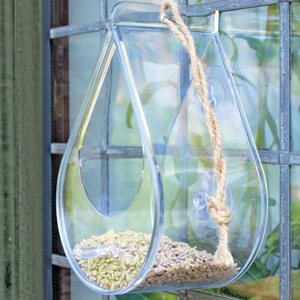
Window Feeders
Get an up-close look at your feathered friends! Most styles of window feeder attach to the glass using suction cups, so they tend to be small and lightweight. Because they hold just a few handfuls of seed, place them where it's convenient to refill them.
Six Types of Birdseed and Other Foods
- Sunflower seed. If you feed only one type of food, make it black oil sunflower seed, the hands-down favorite for attracting the widest variety of birds. Rich in oils and nutrients with a thin, easy-to-crack shell, it's favored by cardinals, chickadees, finches, nuthatches, sparrows, and many more. Larger, thicker-shelled striped sunflower seeds are tougher to open, making them suitable for larger birds with strong bills.
- Thistle seed. A magnet for finches, thistle (also called nyjer seed) requires feeders specially designed feeders, often tubes with small feeding ports or made from fine wire mesh. Otherwise, the seed's small size means it tends to fall out of feeders with large ports and cascades quickly down onto hopper trays, with the result that much of the seed falls to the ground. Thistle is especially attractive to goldfinches, pine siskins, and purple finches.
- Safflower seed. Safflower has a thick shell, which is hard for some birds to crack open, but it is a favorite among cardinals. Some grosbeaks, chickadees, doves, and native sparrows also eat it.
- Millet. Although white proso millet is favored by several types of ground-feeding birds, it tends to attract non-native house sparrows that compete for resources with native species. Golden and red millets are commonly used as fillers in seed mixes. Birds are not particularly fond of these seeds, so the birds tend to ignore them in favor of tastier morsels. The result is that the millet ends up on the ground, attracting rodents and creating a moldy mess.
- Mixed seed. Lesser-quality seed mixes that contain a large proportion of millet are best avoided. Either choose single-seed sources, or mixes that contain the favored foods described above.
- Other. Cracked corn, milo/sorghum, peanuts, and dried berries all have their fans, bird-wise.
Six Tips for Where to Locate Bird Feeders
- Position your feeders within a few feet of a tall bush or a tree, so birds can flit back and forth between a grabbing seed in the open to eating it in the protection of the branches.
- Most feeders can be placed 5 to 6 feet off the ground.
- If squirrels or cats are a problem, you may need to position the feeders further away from shelter and higher up off the ground.
- Place feeders where you can watch the birds from a window. This will also serve as a reminder for when it's time to refill them.
- If possible, locate feeders in a sheltered spot, out of the wind.
- Place feeders in different locations around your yard, so smaller, more timid birds can find a place to dine in peace.
Three Final Tips for Feeding Birds
- Be patient: It may take several days to several weeks before the birds in your area find a new feeder.
- Offer a source of water, such as a shallow birdbath. Birds need a year-round source of fresh (unfrozen) water.
- Foil squirrels with special squirrel baffles, or with feeders surrounded by cages that exclude squirrels (and large, aggressive birds) yet allow small songbirds to access the seed.
This article is a compilation of articles and information by Kathy LaLiberte and Suzanne DeJohn.
Print this Article:
Get the Dirt
Stay up to date on new articles and advice. Please fill out the information below.
